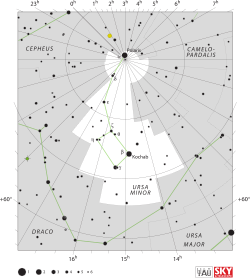Beta Ursae Minoris
| Observation data Epoch J2000 Equinox J2000 |
|
|---|---|
| Constellation | Ursa Minor |
| Right ascension | 14h 50m 42.32580s |
| Declination | +74° 09′ 19.8142″ |
| Apparent magnitude (V) | 2.08 |
| Characteristics | |
| Spectral type | K4 III |
| U−B color index | +1.78 |
| B−V color index | +1.47 |
| Astrometry | |
| Radial velocity (Rv) | +16.96 km/s |
| Proper motion (μ) |
RA: −32.61 mas/yr Dec.: +11.42 mas/yr |
| Parallax (π) | 24.91 ± 0.12mas |
| Distance | 130.9 ± 0.6 ly (40.1 ± 0.2 pc) |
| Details | |
| Mass | 2.2 ± 0.3 M☉ |
| Radius | 42.06 ± 0.91 R☉ |
| Luminosity | 390 ± 25 L☉ |
| Surface gravity (log g) | 1.83 cgs |
| Temperature | 4,030 K |
| Metallicity [Fe/H] | –0.29 dex |
| Rotational velocity (v sin i) | 8 km/s |
| Other designations | |
Beta Ursae Minoris (β Ursae Minoris, abbreviated Beta UMi, β UMi), also named Kochab, is the brightest star in the bowl of the Little Dipper asterism (which is part of the constellation of Ursa Minor), and only slightly fainter than Polaris, the northern pole star and brightest star in Ursa Minor. Kochab is 16 degrees from Polaris and has an apparent visual magnitude of 2.08. The distance to this star from the Sun can be deduced from the parallax measurements made during the Hipparcos mission, yielding a value of 130.9 light-years (40.1 parsecs).
Amateur astronomers can use Kochab as a very precise guide for setting up a telescope, as the celestial north pole is located 43 arcminutes away from Polaris, very close to the line connecting Polaris with Kochab.
β Ursae Minoris (Latinised to Beta Ursae Minoris) is the star's Bayer designation.
It bore the traditional name Kochab which appeared in the Renaissance and its meaning is uncertain. It may be from Arabic الكوكب al-kawkab or Hebrew כוכב kōkhāv, both of which mean 'star', or more likely derived from Alrucaba or Rucaba, a name applied to Theta Ursae Majoris. In 2016, the International Astronomical Union organized a Working Group on Star Names (WGSN) to catalog and standardize proper names for stars. The WGSN's first bulletin of July 2016 included a table of the first two batches of names approved by the WGSN; which included Kochab for this star.
...
Wikipedia

